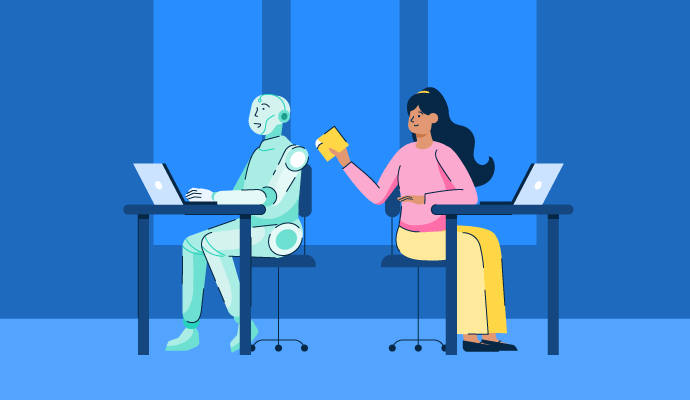
Generative AI is here to stay, and employees are using the new tech big time.
Professionals across sales, marketing, finance, product, engineering, and information technology are all exploring new ways to integrate it into their workflow.
To get a better understanding of generative AI in the workplace, we surveyed professionals. We wanted to know about their opinions, usage, organization policy, and the benefits and challenges of generative AI software at work. Here’s what we found.
Let’s study the numbers more closely.
Nearly a year after generative AI tools became the rage, employees are preparing to incorporate them. Many are already using them for work-related tasks. Here’s the proof showing that gen AI technology is becoming ubiquitous in the modern workplace.
Here, we shed light on the frequency of generative AI tool usage.
The survey results also suggest there’s not much prevailing anxiety or fear of losing jobs to AI among workers. Some professionals even view AI as a catalyst for creating new roles or transforming existing ones.
Generative AI tools have recently become accessible to the public, but users are rapidly integrating them into other software.
Apart from the 21 direct AI categories with 1000+ products, G2 found (generative) AI features added to products in around 200 software categories, from product data management (PDM) to human resource management systems (HRMS). And as the survey data shows, employees are eager to adopt this new technology. Even our earlier software buyer behavior study in 2023 found that 81% of B2B software buyers said it’s important that the software they purchase has AI.
The frequent usage underlines the consistent relevance of generative AI tools in daily work routines. Organizations should recognize the value employees are placing on AI and encourage them to experiment with generative AI tools.
Each department can be tasked with finding the most functional use case for maximum value out of the technology. By strategically integrating these tools into various departments and processes, you boost efficiency, foster innovation, and enhance productivity.
In addition, leadership would do well to remain attentive to the sentiments of those employees who are worried about AI and job security. Proactively address their concerns through training, upskilling, and transparent communication about how your company plans to use generative AI tools. This will build a more resilient and adaptive workforce.
Ready to see which tools are shaping this AI revolution? Explore the best generative AI tools empowering teams to create, collaborate, and innovate faster.
No surprises here. Taking the top spots for the most used generative AI systems are ChatGPT, the conversational AI chatbot by OpenAI, and Bard, from Google. Our data shows professionals most favor open-source, free-to-use AI software.
ChatGPT follows a chain of thought (COT) technique in prompt engineering, which helps generate text, art, images, video, audio, and other deliverables to integrate in your business workflows, including applications in AI chatbot development.
The dominance of ChatGPT suggests it has gained widespread trust among professionals for a diverse range of applications. Take this into consideration and create ChatGPT-specific guidelines for your employees to use when they’re designing prompts or uploading data into the AI chatbot. This will ensure they’re applying the tool in a way that matches your organization’s acceptable use policy.
How are employees using generating AI tools for work tasks? Well, it looks like a lot of text and codes. Matthew Miller, Principal Analyst at G2 focused on AI, is not surprised. He noted that this is consistent with the findings from our inaugural State of Software report, which shows that the fastest-growing AI category on G2 was synthetic media.
Nowadays, employees rule in favor of using AI for research and development to save their energy and optimize team bandwidth.
Take note of these trends and consider how the use cases can be integrated into your organization’s workflows, particularly in areas such as content creation and software development. It’s also important to provide guidelines for AI content generation and code creation that adhere to your company's policies and procedures.
The vast majority of employees who use generative AI tools at work report significant benefits. Tasks like document management, content creation, sorting of lists, strategy development, and customer communication have been automated, which reduced manual intervention and increased quality and overall team efficiency.
These findings suggest that generative AI tools have the potential to make a significant impact on the workplace. By automating tasks, generating creative content, and solving problems, generative AI tools can free up employees' time to focus on more strategic work.
Take text generation, for example. Whether it's composing emails, writing reports, or making product descriptions, generative AI's capacity to create content at scale saves time and reduces manual effort. And the benefits are likely to increase as the technology continues to develop.
So, it’s important to explore the tools early to enjoy the advantages. Survey the leading users within your organization to find out what they've experienced. Use the information to construct a compelling and practical use case for generative AI.
Within the workforce, there is a good amount of awareness about the potential risks associated with the adoption of generative AI tools.
Unlike consumers who use AI for personal purposes, businesses must navigate a complex regulatory landscape and consider the potential legal, financial, and ethical implications of generated content.
While a substantial portion of employees are aware of the potential for harm, organizations should take steps to mitigate the risks associated with using generative AI tools. This includes providing employees with training on how to use these tools safely and effectively, developing policies and procedures for the use of generative AI tools, and implementing measures to protect data privacy and security.
While generative AI tools are gaining traction, organizations are using them at their own discretion. Take a look at the current state of implementation and policies within companies.
On one side, a majority of organizations have either started implementing or actively exploring the potential of incorporating generative AI tools into their tech stack and workflows.
A big bummer here is that a substantial portion of companies appear ill-prepared for the widespread use of generative AI.
With a lack of clear guidelines or restrictions on gen AI from the company, employees are using them without seeking approval.
It’s impossible to keep track of a growing list of AI tools. G2 alone tracked 643 new products in our AI categories between Sept. 1, 2023, and Sept. 1, 2024. And given how easy it is to access these tools, their usage will be difficult for companies to quell.
The absence of organizational policy and approval results in shadow IT and creates unnecessary compliance and security risks. So, the best way for your company to mitigate these risks is to proactively be aware of the tools used within the organization and how employees use them.
Your information security (InfoSec) and privacy team need to take stock of the situation and provide guidelines around generative Al tools and ChatGPT for individual usage to enhance employees’ work productivity and processes. This will make your business an enabler of new technology while addressing security concerns, too.
In September 2023, G2 conducted a pulse survey of professionals who left reviews on G2.com in software categories relevant to generative AI, including but not limited to synthetic media, generative AI software, and AI software. The data above reflects responses from 170 professionals across sales, marketing, finance, accounting, operations, product, engineering, human resource, and IT, representing companies of various sizes and sectors.
Check out the generative AI trends in 2024 to see what's next for the worldwide AI evolution and how organizations will deploy them on a grander scale.
Soundarya Jayaraman is a Content Marketing Specialist at G2, focusing on cybersecurity. Formerly a reporter, Soundarya now covers the evolving cybersecurity landscape, how it affects businesses and individuals, and how technology can help. You can find her extensive writings on cloud security and zero-day attacks. When not writing, you can find her painting or reading.
We’ve been tracking the rise of AI search and predicting its impact on the tech landscape...
 by Kamaljeet Kalsi
by Kamaljeet Kalsi
AI visibility platforms, like Radix or Promptwatch, have found G2 to be the most cited...
.png) by Kevin Indig
by Kevin Indig
The world of AI search is moving fast, and this week’s news is all about Reddit and OpenAI. Or...
.png) by Kevin Indig
by Kevin Indig
We’ve been tracking the rise of AI search and predicting its impact on the tech landscape...
 by Kamaljeet Kalsi
by Kamaljeet Kalsi
AI visibility platforms, like Radix or Promptwatch, have found G2 to be the most cited...
.png) by Kevin Indig
by Kevin Indig


